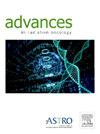在接受质子放射治疗的儿童肿瘤患者大队列中自我报告健康状况调查的创建和分布结果
IF 2.7
Q3 ONCOLOGY
引用次数: 0
摘要
目的:大多数在麻省总医院接受放射治疗的儿科患者是从外部机构转介的,后来又回到原来的护理提供者那里。作为四级护理中心,质子治疗中心在跟踪患者随访方面面临着独特的挑战,然而获得纵向数据对于评估放射治疗结果至关重要。我们实施了年度直接对患者的调查,以改善随访数据收集。方法和材料调查设计在5分钟内完成,并记录联系信息、健康状况(最近的随访和与专家的随访、影像学、治疗的疾病/继发性肿瘤的状况、额外的治疗和症状)以及社会更新。调查每年以带有快速响应代码的邮寄信件或使用研究电子数据采集软件的电子邮件的形式发送。数据收集于2019年2月至2022年6月。我们已获得批准,可以向预期参加临床试验或儿科质子/光子联盟注册中心的肿瘤患者发送调查问卷。结果在472名参与者中,有236人(50%)回复了至少1份调查问卷。通过电子邮件接受调查的患者的回复可能性是通过邮件接受调查的患者的1.6倍(P <;措施)。邮寄和电子邮件调查完成调查的中位时间(天)分别为20和3。调查完成后,患者的最后可用临床记录状态中位数延长了8.5个月(<1-63.3个月)。结论调查的实施改善了后续数据的收集,电子邮件作为分发方式比邮件更有效。我们的调查在其他三级和四级中心的适应和利用可能会改善患者结果的收集。本文章由计算机程序翻译,如有差异,请以英文原文为准。
Self-Reported Health Status Survey Creation and Distribution Outcomes in a Large Cohort of Pediatric Oncology Patients Treated with Proton Radiation Therapy
Purpose
Most pediatric patients receiving radiation therapy at Massachusetts General Hospital are referred from outside institutions and later return to their original care providers. As quaternary care centers, proton therapy centers face unique challenges in tracking patient follow-up, yet obtaining longitudinal data is crucial for assessing radiation therapy outcomes. We implemented an annual direct-to-patient survey to improve follow-up data collection.
Methods and Materials
The survey was designed to be completed in <5 minutes and records contact information, health status (recent follow-up and with which specialists, imaging, the status of treated disease/secondary tumors, additional treatments, and symptoms), and social updates. Surveys were sent annually as mailed letters with a quick response code or by e-mail using research electronic data capture software. Data were collected between February 2019 and June 2022. Approval was obtained to send surveys to oncology patients prospectively enrolled in a clinical trial or the Pediatric Proton/Photon Consortium Registry at our single institution.
Results
Of the 472 participants who were sent at least 1 survey, 236 (50%) responded. Patients who received surveys via e-mail were 1.6 times as likely to respond than those who received surveys via mail (P < .001). The median time (days) to survey completion for mailed and e-mailed surveys were 20 and 3, respectively. Survey completion extended the last available clinical status on record for patients by a median of 8.5 (<1-63.3) months.
Conclusions
Survey implementation improved follow-up data collection, with e-mail being more effective than mail as a distribution method. Adaptation and utilization of our survey in other tertiary and quaternary centers may improve the collection of patient outcomes.
求助全文
通过发布文献求助,成功后即可免费获取论文全文。
去求助
来源期刊

Advances in Radiation Oncology
Medicine-Radiology, Nuclear Medicine and Imaging
CiteScore
4.60
自引率
4.30%
发文量
208
审稿时长
98 days
期刊介绍:
The purpose of Advances is to provide information for clinicians who use radiation therapy by publishing: Clinical trial reports and reanalyses. Basic science original reports. Manuscripts examining health services research, comparative and cost effectiveness research, and systematic reviews. Case reports documenting unusual problems and solutions. High quality multi and single institutional series, as well as other novel retrospective hypothesis generating series. Timely critical reviews on important topics in radiation oncology, such as side effects. Articles reporting the natural history of disease and patterns of failure, particularly as they relate to treatment volume delineation. Articles on safety and quality in radiation therapy. Essays on clinical experience. Articles on practice transformation in radiation oncology, in particular: Aspects of health policy that may impact the future practice of radiation oncology. How information technology, such as data analytics and systems innovations, will change radiation oncology practice. Articles on imaging as they relate to radiation therapy treatment.
 求助内容:
求助内容: 应助结果提醒方式:
应助结果提醒方式:


